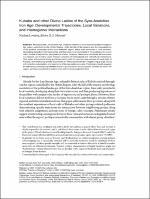Chapter Kubaba and other Divine Ladies of the Syro-Anatolian Iron Age: Developmental Trajectories, Local Variations, and Interregional Interactions
Author(s)
Lovejoy, Nathan
Matessi, Alvise
Language
EnglishAbstract
Already by the Late Bronze Age, culturally distinct cults of Kubaba existed throughout the region controlled by the Hittite Empire. After the fall of the empire and the fragmentation of the political landscape of the Syro-Anatolian region, these cults persisted in local contexts, developing along their own trajectories, and thus producing hypostases of the goddess with unique roles, modes of expression, and perhaps aliases. However, these local variations did not evolve in a vacuum, but in many cases through a process of interregional and intercultural interactions. This paper will examine these processes along with the resultant expressions of local cults of Kubaba, demonstrating specific trajectories for interactions between neighboring groups, along with selective adaptations and rejections of foreign cultic concepts. Preliminary results suggest an interesting convergence between these cults and certain sociolinguistic boundaries within the region, perhaps connected to communities with shared group identities.
Book
Theonyms, Panthea and Syncretisms in Hittite Anatolia and Northern Syria; Theonyms, Panthea and Syncretisms in Hittite Anatolia and Northern SyriaKeywords
Kubaba; Iron Age; Religious contacts; Syro-Anatolian cultsDOI
10.36253/979-12-215-0109-4.12ISBN
9791221501094, 9791221501094Publisher
Firenze University PressPublisher website
https://www.fupress.com/Publication date and place
Florence, 2023Series
Studia Asiana, 14Classification
History


 Download
Download Web Shop
Web Shop